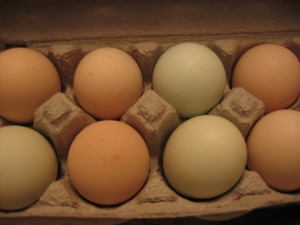I read Plenty about a month ago and casually asked Keifel if he would be interested in an experiment to see if we could eat locally for a year. To my surprise, he said yes. So, the adventure will begun in earnest May 1. We were planning to start the first day of spring, as in the book, but after a week of realizing we would be eating eggs for two months, we postponed. We did decide we would start mostly sourcing locally and that we should eat anything already in the house because it would be wasteful otherwise. I am all about having a pantry, so we have quite a bit of non-local stuff to play with.
I started out that first spring week by foraging at the Produce Place on Murphy Road because I had seen local produce there from Mennonite farms in the past. They had produce from everywhere but here, but they did have some local biodynamic sweet potatoes. I bought four pounds. They were very dirty, not a problem, and spindly enough to poke a hole right through my bag. They also had some local cheese. I got a chunk of smoked cheddar but it looked a little plasticky through the plastic and is still in the fridge, untouched. My last two things there were local, raw sourwood honey (which is amazing, I can’t even describe the flavor) and local sorghum. We went to Whole Foods that Tuesday because they also carry local produce occasionally. All they had was local eggs, local milk and a teeny bit of local lamb and local beef. We then had not very many vegetables and a lot of animal parts or products.
We had a crazy week but mostly ate stuff from the pantry including local eggs and such as we went. Another stipulation was that if we ate out it had to be a locally owned restaurant preferably one that sourced locally. Fido is really the only one in our current budget. We also had dinner with friends at Rose Pepper. Another rule was that we not be assholes in turning down hospitality, gifts or invitations because of this. Trading the goodwill and fellowship of our friends and family for our experiment seems, well, like being assholes.
That Friday, we went to the Turnip Truck in East Nashville and scored some much better local goat cheese and local buttermilk. Jules and I hit up the Nashville Farmers Market on Saturday and got greenhouse lettuce, turnip greens, local chicken and more local milk, non-homogenized, so I could take a stab at making yogurt. (Still hasn’t happened.) All told, our foraging that week was successful. Also, somewhere along the way I bought coffee beans from Bongo Java Roasting Company. I chose not to give up coffee but to switch to locally roasted by a local business that uses organic and fair trade beans. I had been drinking fair trade organic, but not local.
The high point of our first week of eating local was a cottage pie with local beef, local sweet potatoes, local milk, and local herbs. The carrots and celery and garlic were leftover from the larder. The celery is now done and I really wished I’d had onions. We also ate the local lettuce with a honey mustard vinaigrette. Olive oil is also on my list of things I can continue to buy if it is organic and preferably Californian (as that is the closest olive production, we think). Julian and Keifel loved both the pie and the salad. Jules said if eating local is like this all year, he is totally in.
Things have continued. The new Saturday ritual is dropping Keifel to work, did I mention we also down-sized to one car?, and then having coffee and a pastry at Provence (and buying bread from them if we need it). Then heading to the farmer’s market. We are converts to JD Farms milk. We have tried whole (cream comes to the top!), skim and 2%. Jules has settled on the 2% and since he drinks it straight, he gets the deciding vote. They also have a wicked good chocolate milk. We get eggs from several vendors but the ones I got this morning are a lovely mix of pink and blue with a couple extra jumbo-sized and a teeny bantam egg as well. I got the eggs, some beautiful arugula, and sweet little white turnips with full, lusty tops from Common Grounds. There are two cheese vendors now. One for locally made goats milk cheeses and one that deals in American artisanal cheeses. I picked up an aged farmhouse cheese from N. Alabama. I am thinking a salad with a little of that crumbled over. I also got a pound of bacon from Emerald Glen Farms. The chicken we got from them last week was amazing. I also got a pork roast from Walnut Hills Farm. I got goat stew meat from them last week that Keifel curried in the Trinidadian manner with a little local lamb from Whole Foods. Another local dinner winner.
So, after a almost three weeks of dabbling, things are getting ready to head for the big time. I know that we are really going to have to carve out some time to do more ahead-of-time prep for breakfasts and lunches because we are crazy busy with so many jobs and one car scheduling. Our volunteer schedule calms down that second week of May and I am hoping to get stuck in to working on one or both of the books in progress. Our first CSA delivery from Avalon Acres is also that first week of May, so we will at least have something to eat even if I can’t make it to the Farmer’s Market.
We are preparing some herb beds around the house with some free bricks from Cajun Scorpio Girl and Mark the Carpenter. Julian and I dug one of them out last weekend but this weekend has been too hectic, as will next… We are planning to get a raised bed and get some tomato plants, pepper plants and, if possible, some pickling cucumbers (I love gherkins!). Julian and I started some herbs from seed and some of them actually lived and have sprouted which of course means we need to get on those herb beds.
I thought long and hard about this and I really think that local food is the best way forward for the planet, for the people and for food security. I don’t want to get too involved in being a screamy evangelist about it but I am hoping that with this blog, the supper club, twitter and facebook, I can talk about it to those who are interested in listening in on and seeing pictures from our adventure.
To have some guidelines we came up with a list of allowable indulgences (necessities, more like it!) and some ground rules. Our lives are pretty hectic and we didn’t want this to make it worse. It’s hard to make it look appealing if you are having a nervous breakdown in the process. Here’s our starting point:
Ground Rules:
1. Try for as much of our diet as possible to come from within 100 miles.
2. When travelling or receiving hospitality we will eat what is offered. (The “Don’t Be Assholes*” rule.)
3. We will accept food gifts graciously, even those from far outside the 100 mile limit. (*)
4. It is impractical to put the 100 mile restraint on catering gigs and the supper club, though we will make every effort to continue to source sustainable produce for those functions, especially the supper club.
5. We will make every effort to investigate local wild foods, fish and game. (I am trying to set a date for some trout fishing and have a line on a free -yay!- smoker).
6. We will acquire a small, energy efficient freezer; can as much as we can; and use the dehydrator (that has been in the attic for three years) to preserve as much as we can for the winter and early spring next year when we know fresh, local produce is in short supply.
7. We will plant a small garden this year, focusing on easily preserved items and herbs.
8. We will continue composting.
9. We will avoid food waste by creatively using up leftovers as soon as possible.
Exempt Items:
(the list was supposed to be 10 but we forgot a couple things on the first one and hope to delete some if we find local sources)
1. coffee, must be fair trade and organic and roasted locally
2. tea, organic and fair trade and only if we run out of our current supply
3. olive oil, organic and preferably Californian
4. citrus fruit, but not juice (I have to be honest and say that a life without lemons seems horribly bleak to me)
5. spices, but herbs must be local if not home grown
6. salt, preferably sea salt
7. American grown rice
8. Beer, but must be brewed locally even if the raw ingredients come from somewhere else
9. chocolate, must be fair trade and made locally
10. kefir, until I get my own yogurt set up going (my belly would otherwise not be the same)
11. steel cut oats
12. peanut butter, all natural and organic, unless we can find a 100-mile source (to prevent Jules from starvation)


